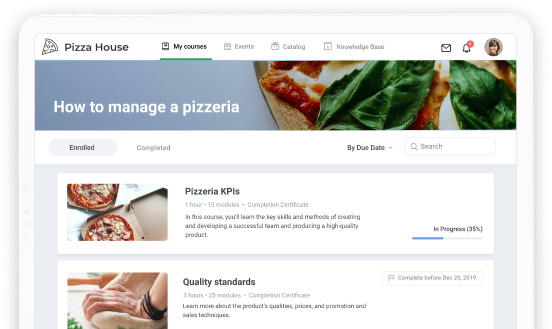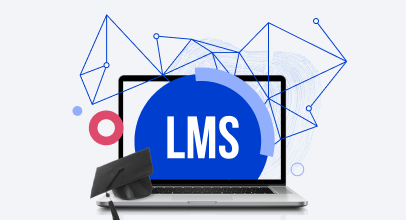Training Program Evaluation: How to Achieve Perfection

Many businesses train their staff to boost their productivity and work performance. But how can you tell if it’s successful? And how do you identify what needs tweaking in your courses to make them more effective? The ideal approach is to start evaluating your training programs.
This piece will guide you through understanding the training evaluation process, its critical role, and the benefits it can bring to your company. It will also shed light on the best evaluation models and tools you can use to assess your program’s effectiveness.
What Is Training Program Evaluation?
Training program evaluation is the regular analysis of how efficient and effective training programs are. This process includes collecting participant feedback, assessing job performance improvements post-training, aligning with corporate strategic goals, and much more.
Why Evaluate Training
It allows companies to make sure that the time and money spent actually help employees learn and grow. It shows what worked well and what didn’t, so future training can be improved. Finally, it checks if the training helps people do their jobs better, which is the main goal.
Benefits of Training Evaluation
Evaluating training effectiveness obviously requires additional resources, but the advantages far exceed the challenges. In short, it helps companies:
- Identify training gaps. A part of training evaluation is to assess the quality of employees’ work, which might reveal some loopholes in training programs. For example, if quiz outcomes reveal widespread failure on data security questions, a closer look may show the topic isn’t covered thoroughly. As a result, you might want to add an additional module on data security to the training program.
- Cut costs. By comparing training costs to training outcomes, companies can discern the profitability of their courses. This helps to identify which training programs are valuable and which are not, saving both money and time.
- Improve materials and tools. Without training evaluation, it’s challenging to measure the quality of learning content and the efficacy of training tools. Do learners quit after just a few slides? Maybe your introduction isn’t catching their attention. Consider making a motivational video to spark their interest and show why the course matters. By looking at the evaluation results, you can see both weak and strong points, and then tweak your training programs to improve them.
Training Evaluation Models: A Guide to the Best
To evaluate training programs more systematically, you can use specific training evaluation models. There’s a wide selection of them, with each providing a unique approach to course assessment. We’ve identified 5 models that stand out as being the most popular and trusted over the years.
Kirkpatrick’s Four-Level Training Evaluation Model
One of the oldest and, without a doubt, the most famous is The Kirkpatrick Model. Even now, after more than sixty years since it was developed, it’s still widely used.

This model suggests evaluating training programs across four levels: Reaction, Learning, Impact, and Results. Let’s delve into each level.
Level 1: Reaction
Once learners complete your course, assess their reactions. Have them fill out a survey, asking questions such as:
- How satisfied are you with the training experience?
- Did the training content meet your expectations?
- Did you learn anything new?
- How would you rate the quality of the training?
- Do you find this training useful?
For more nuanced feedback, consider a Likert scale survey. Unlike binary questions, a Likert scale survey offers shades of opinion beyond simple yes/no answers, which can enrich your evaluation insights.

Level 2: Learning
Measure how much was learned in the course. For example, consider using online quizzes to gauge the knowledge and skills your learners gained or missed out on during training. For even more accurate insights, some companies opt for pre-quizzes. This approach lets you clearly understand what your learners knew before starting the course and what they have learned by completing it.

Level 3: Behavior
Observe any changes in an employee’s behavior following the training. The most effective way to do this is to use 360-degree feedback — gather evaluations from the employee’s colleagues, supervisors, and subordinates before and after the course. This comparison reveals the training’s impact on behavior.
Level 4: Results
This level is the cornerstone of training evaluation. After all, better results are the primary goal of corporate training. Assess the impact of your course on the business by assessing subsequent improvements in quality, efficiency, productivity, and customer satisfaction.
Although The Kirkpatrick Model is extremely effective, it has some limitations we need to mention:
- Limited application. It can only tell you whether your training works or not. That means if you use this model, you won’t get data that helps improve the course per se.
- Questionable structure. The idea of linear causality suggested by Don Kirkpatrick lacks substantial backing. This means there’s no guarantee that positive feedback at one level ensures success at the next.
Don Kirkpatrick himself recognized these issues and suggested a better way of using his method: begin with the end in mind. By starting from the desired outcomes and working backward through the four levels during the design phase, you can tailor your training program to achieve your specific goals.

The Phillips ROI Model
You can think of the Phillips ROI model as an upgrade to Kirkpatrick’s framework. It mirrors the levels of The Kirkpatrick Model, with a crucial addition at the end — return on investment (ROI). Unlike The Kirkpatrick Model, which focuses on Return on Expectations (ROE), the ROI model can actually let you know if it was the right decision to invest in a training program.

How to measure ROI with the Phillips model:
Collect data on the status before, during, and after the training to assess its impact on your company’s earnings, productivity, and performance. Then, compare the training cost to the benefits it provides. If the benefits to the company’s bottom line surpass the costs, you’re on the right track. If they don’t, pinpoint which level or levels of training evaluation fell short and refine your training approach.
Kaufman’s Five Levels of Evaluation
Building on the Kirkpatrick Model, Roger Kaufman introduced a five-level framework. He split the first level into two parts, combined Kirkpatrick’s second and third levels into ‘micro’ levels, and introduced a fifth level to assess outcomes for both customers and society.

Here’s how to use Kaufman’s five levels of evaluation:
Level 1a: Input
Track the resources, like time and money, that were invested in your training program.
Level 1b: Process
Gauge how participants felt about the course.
Level 2: Acquisition
To assess the specific benefits of your training, check if it meets the goals for individual learners or small groups. This involves finding out whether your learners have gained new knowledge and skills.
Level 3: Application
Assess learners’ ability to apply new knowledge and skills to their work.
Level 4: Organizational payoffs
Measure payoffs for your company as a whole. A payoff can be an improvement in employee performance, a reduction in costs, or increased profits.
Level 5: Societal Outcomes
At the final level, you are to evaluate the impact that your course has on what Kaufman calls ‘mega-level clients.’ By these, he means business clients or society.
Kaufman’s framework isn’t entirely applicable to real-world scenarios. Measuring how much impact your training has on society is often too costly, complex, and impractical. However, Kaufman introduced some valuable concepts, such as dividing the first level into two and evaluating the content you deliver and the resources you invest separately. Some of his levels can serve as enhancements to your basic model.
The CIRO Model
CIRO stands for Context, Input, Reaction, and Output. This model is designed for evaluating management training. So, if you want to assess management courses, it is an ideal choice.

Stage 1: Content
Assess your company’s current situation. Identify all the factors that could influence the training results. At this stage, also pinpoint where your organization falls short in performance. As a result, you’ll have a list of needs that should be organized according to the following three levels:
The ultimate objective
The ultimate objective is the elimination of organizational shortcomings, such as poor customer service, low productivity, or low profit.
Intermediate objectives
These are the steps needed to reach the ultimate objective. They often involve changes in employee behavior.
Immediate objectivesAs immediate objectives can help change employees’ behavior, they usually involve the acquisition of new skills and knowledge from training, or shifts in their attitudes.
Stage 2: Input
At this stage, your aim is to pinpoint the optimal training intervention. Explore all possible methods and techniques for training. Also, think about how you will design, manage, and deliver your course to your learners. Assess your company’s resources to figure out the most effective way to use them to achieve your objectives.
Stage 3: Reaction
At this stage, collect feedback from your learners about the course. Focus on three key areas:
- Program content
- Approach
- Value addition
Your goal isn’t just to find out if they liked or disliked the course, but also to gather insights on any changes they suggest for the training program. Note their recommendations for future improvements.
Stage 4: Output
In this stage, it’s time to showcase the outcomes of the training through four distinct levels of measurement:
- Learner
- Workplace
- Team or department
- Business
Select the level that aligns with your evaluation’s objective and the resources you have.
Anderson’s Model of Learning Evaluation
Unlike other models, Anderson’s Value of Learning Model takes a broader perspective, concentrating on a company’s overall learning strategy instead of just a specific training program. It consists of three stages that help to identify the most suitable learning strategy for your organization’s needs.

Stage 1
Determine if the existing learning programs align with your company’s strategic priorities. Going back to our example, suppose that the strategic goal is to boost sales and strengthen market position. Does the training for salespeople target these objectives? The answer is yes.
Stage 2
Evaluate the impact of learning on strategic outcomes. At this point, our company uses different measures to assess how much effect the training has had on accomplishing the primary goals. By analyzing the data, we find that the program boosted sales numbers. However, it didn’t result in a larger market share for the company. Moreover, as time passed, we observed a decline in customer numbers because the waiting time was too long.
Stage 3
Select the most relevant approaches for your company. The choice of approach depends on stakeholders’ goals and values. Anderson introduced four categories of measurement:
- Emphasis on short-term benefits
- Emphasis on long-term benefits
- Senior management trust in learning contribution
- The organization requires learning value metrics
Below is a table designed to help you identify the best approach for your organization.

You should choose a category that’s relevant to your situation and establish an approach that will help fulfill your organizational needs.
Training Evaluation Tools
Training evaluation tools are what you use to assess training programs. They typically fall into four categories: questionnaires, interviews, focus groups, and observations. We’ll also include an additional one — LMS reporting. For the most thorough and accurate assessment, it’s common to use these training evaluation methods together. Now, let’s look at each one in greater detail.
Questionnaires

Questionnaires stand as the most frequently used method for training evaluation. They consist of a set of questions designed to gather valuable insights from participants. This tool is great for assessing learners’ reactions after a program.
Pros
- Enables the collection of a large amount of information
- Economical in terms of costs
- Saves time
- Reaches a broad audience
Cons
- Often results in a low response rate
- Might include unreliable responses
- Cannot clarify vague answers
- Questions can be interpreted subjectively by participants
There is a broad range of software for creating quizzes and surveys. For interactive, customizable, and engaging questionnaires, consider giving iSpring Suite a try. This software enables you to design 14 different types of questions, add images to both questions and answers, and use many other features to assemble questionnaires that truly deliver results.
Moreover, iSpring Suite isn’t just for evaluating your training programs — it’s also a powerful tool for creating them. This toolkit lets you develop online courses directly in PowerPoint and enhance them with quizzes, role-plays, screen recordings, and interactions. To get a sense of the kinds of courses and questionnaires you can create with iSpring Suite, take a look at this interactive module.
Interviews
Interviews are designed to collect both opinions and facts. They offer a deeper dive than questionnaires into employees’ attitudes, behaviors, and mindsets. Interviews aren’t restricted to traditional face-to-face formats; they can also be conducted over the phone or online.
Pros
- Provides an enhanced understanding of employees’ perspectives
- Allows you to ask clarifying questions
- Offers flexibility
Cons
- Requires a significant investment of time
- Limited reach, addressing learners one-on-one
Focus groups
This method combines the best of both questionnaires and interviews, allowing you to reach a broad audience while also gathering deep insights. If you’re in search of qualitative data to gain a comprehensive understanding of employees’ viewpoints but lack the resources for individual interviews, focus groups could be the solution.
Just group individuals based on specific traits relevant to your target audience, like job area, common performance errors, or age. Then, facilitate a group discussion to gather their reactions, insights, feedback, and recommendations.
Pros
- Gathers detailed feedback from multiple individuals simultaneously
- Allows for targeted questions to gain specific insights
Cons
- Requires a considerable amount of time
- Needs a team for management, including a moderator and an assistant
- Requires an environment that is conducive to open and honest communication
Observations
Observation is perhaps the most effective method to witness changes in behavior and attitude after training. It stands out because it doesn’t depend upon what employees say about themselves or others. By simply observing someone at work, you can see firsthand if they’re applying new skills and knowledge. However, this approach does have its limitations.
Pros
- Cost-effective
- Offers a realistic perspective, free from opinion bias
- Captures valuable non-verbal information
- Can be implemented upon completion of the course
Cons
- Requires time, focusing on one individual at a time
- Might provide unreliable information, as people tend to improve their behavior when observed
- Observations can be misinterpreted
- Fails to uncover the reasons behind an employee’s attitude or behavior
LMS reporting
A learning management system (LMS) is software for delivering online programs to your learners. Within this system, there is another system, LMS reporting, that collects and analyzes data from your online programs. This functionality enables you to identify the weaknesses in your courses. Imagine that you’ve developed a training program and rolled it out to your employees. If you notice a lack of visible progress over time, consult the LMS reports.

There, you might notice that most of your employees abandoned the course at a specific point. You identify this section in the program, analyze for potential gaps, and then address them. Over time, you’ll see the results — employees continue the course and finish it successfully.
Pros
- Saves time
- Automates the evaluation process
- Offers objective feedback from the system
- Easily identifies weaknesses in the training program
- Available 24/7
Cons
- Limited to online programs only
- Doesn’t delve into the reasons behind an employee’s attitude or behavior.
Discover the advantages of an LMS and its reporting capabilities firsthand by signing up for
a free trial of iSpring Learn. Beyond generating reports, iSpring Learn allows you to build courses, incorporate gamification into your eLearning, automate routine tasks, and much more.
When Is the Best Time to Evaluate Training?
Training programs can be evaluated either while they are being developed or after they’ve been delivered. These evaluation methods are known as formative and summative, respectively. Let’s dive deeper into each type.
Before training is launched (formative)
Formative evaluation helps you identify and resolve issues in your course before it reaches learners. You might conduct a user acceptance test to ensure that the eLearning platform functions well, or invite a focus group or a subject matter expert to review the training to uncover any potential weaknesses or mistakes.
After training is completed (summative)
Summative evaluation occurs once learners have finished the course. It involves methods like surveys, interviews, and tests to gather feedback from participants. This feedback enables you to refine the program for future learners.
Both evaluation types are crucial for enhancing training programs. Ideally, a company should assess their training both before and after delivery. However, resources may not always permit this comprehensive approach. Yet, opting for even one evaluation type can still significantly improve your training system.
To Sum Up
There are numerous evaluation methods and tools available to assess training programs, each with its advantages and drawbacks. This variety means there’s no need to pin down a single “best” approach. However, it’s safe to say that employing a mix of models and tools, tailored to your company’s specific goals and objectives, is the most effective evaluation strategy.
We hope you found this article useful. Now that you understand how to evaluate training programs, make sure to explore how to develop training programs. Good luck!











